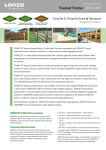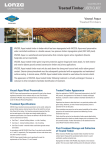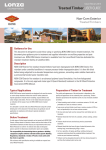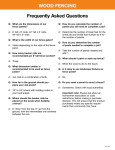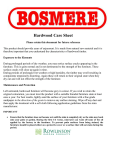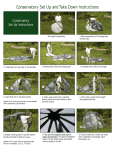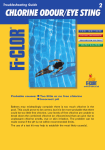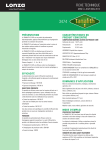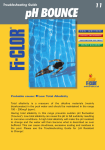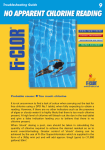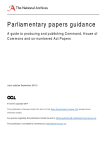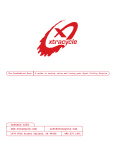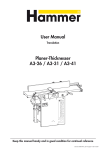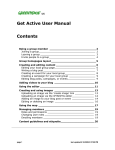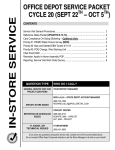Download TANALITH Treatment USER GUIDE
Transcript
Issued March 2015 TANALITH Treatment USER GUIDE Tanalith E, Tanalith Extra & Tanatone Definitions TANALITH E pressure treated timber is timber which has been impregnated with TANALITH E wood preservative under controlled conditions in a vacuum pressure timber impregnation plant. TANALITH E is a water based wood preservative that contains copper and organic biocides (triazoles). When impregnated into the timber the preservative components bond with the wood structure and cannot easily be removed. TANALITH E pressure treated timber has a long term protection against fungal and insect attack, including termites, for both in and out of ground contact, interior and exterior applications when treated to the correct end use specification. TANALITH E pressure treated timber has an initial natural green colouration. Upon external exposure, the green colour slowly weathers to a warm, honey brown and in the longer term becomes a natural silver grey. This weathering process does not indicate any loss of preservative protection. TANALITH E pressure treated timber is also available with built-in water repellent (TANALITH Extra) or built-in brown colour (TANATONE). With the benefit of water repellent properties, TANALITH Extra pressure treated timber is ideal for outdoor leisure and decorative timbers such as decking, cladding and playground equipment. TANATONE treated timber has a brown colouration as opposed to the traditional TANALITH green. It is ideal for rough sawn timber fencing and landscaping applications. TANAGARD is a solution sterilant to be mixed in pre diluted TANALITH E preservative solution as part of the treatment process to protect it against biological contamination. Recommendations provided for TANALITH E pressure treated timber apply equally to TANALITH Extra and TANATONE pressure treated timber, unless otherwise stated. Companies operating timber impregnation plants require a permit to operate from the appropriate local/regional approving authorities which are country specific. The size and throughput of the impregnation plant installation will dictate the required level of permissions. Arch Timber Protection can provide more information, if required. TANALITH Treatment USER GUIDE Tanalith E, Tanalith Extra & Tanatone TANALITH E Wood Preservatives TANALITH E wood preservatives are approved for use by the relevant regulatory authorities in the markets it is used. The biocides contained in TANALITH E wood preservatives are being supported under the Biocidal Products Regulation. Biocidal Products Regulation - Treated Timber Labelling As part of the Biocidal Products Regulation (BPR) it is now the responsibility of suppliers of preservative treated timbers who are first putting the product on the market within the European Union to label the treated timber with information relating to the claimed protection, the active biocidal ingredients the preservative contains and relevant end use phrases for the treated timber. This information should also be in the relevant language for the intended market of the treated timber. Arch Timber Protection can assist TANALITH E preservative treaters with print ready artwork for these labelling purposes, if required. CE Marking As part of the Construction Products Regulation the CE marking of permanently installed preservative treated construction timbers is now required. Contact Arch Timber Protection directly for further guidance, if required. Industrial Emissions Directive The Industrial Emissions Directive (IED), depending on the theoretical treatment plant capacity, may apply to treatment plant installations. Contact Arch Timber Protection directly for further guidance, if required. Treatment Specifications TANALITH E treatment process parameters can be varied, taking into account timber species, desired service life and to match the end use (Use Class) of the timber. It is therefore extremely important that the end use and species of the timber are clearly stated within the treatment specification. Use Classes are defined in EN 335:2013 but can be summarised as follows: • Use Class 1 - internal building timbers - no risk of wetting. • Use Class 2 - internal building timbers - risk of wetting. • Use Class 3 coated - external timbers used above ground contact and coated. • Use Class 3 uncoated - external timbers used above ground contact and uncoated. • Use Class 4 - external timbers used in ground or fresh water contact. In accordance with EN 335:2013 Use Class 3 can also be sub-classified as 3.1 and 3.2 respectively. The interpretation of these sub-classes may vary from country to country. TANALITH E pressure treated timbers can be produced for any of the above Use Classes. Technical Data Sheets A technical data sheet for TANALITH E, TANALITH Extra, TANATONE and TANAGARD will be supplied by Arch Timber Protection prior to commissioning. These documents give specific information on the use of the relevant product. Technical data sheets should be consulted by the treatment company as a product reference guide. It is the responsibility of the treatment company to ensure all relevant permits and risk assessments are in place and current when using TANALITH E and associated additives. Preparation of Timber Prior to Treatment Prior to treatment with TANALITH E timber should be presented to the treatment plant in a dry and clean condition: • Generally, timber should be dried to a moisture content equal to or below the fibre saturation point, around 28%. • For the treatment of some species, (e.g. Spruce), the optimum moisture content may be greater than the fibre saturation point and Arch Timber Protection can advise on this, if required. • If timber is force dried, in a kiln for example, the correct kiln cycle should be selected to ensure sapwood penetration is not blocked by overly rapid drying. • It is important that the moisture content is assessed in the zone to be treated (typically the sapwood) prior to treatment by an appropriate method described in EN 13183:2002. • All inner or outer bark should be removed. • Timber should be free from dirt, sawdust, surface coatings, surface water, plastic wrapping, ice and snow. • Timber should not be frozen, generally temperature greater than 5°C. • Timber should be free from all signs of attack by bacteria, blue staining fungi, wood destroying fungi or insects. • As far as possible all cutting, machining, planing, notching and boring is to be carried out prior to treatment (see section on post-treatment machining). • DO NOT attach metal fittings prior to treatment. • DO NOT excessively tighten any banding around the timber packs. • If possible tilt the timber packs on the treatment plant bogie. • Use sticker-stacked pack configurations to optimise post-treatment drying. Treated Timber Appearance TANALITH E treated timber can show a characteristic colour difference between the sapwood and heartwood immediately after treatment and for the first 48 hours, after which the timber will take on an even green appearance. Some colour variations may occur due to the natural variability and relative proportions of heartwood and sapwood in certain species and darkening of some hardwoods may occur. Upon external exposure, the initial green colour of TANALITH E treated timber slowly weathers to a warm, honey brown and in the longer term becomes a natural silver grey. This weathering process does not indicate any loss of preservative protection. If required, the green colour of TANALITH E treated timber can be refreshed at any stage using coating products such as RESTOL Wood Oil, available in Garden Timber Green. Always follow the coating manufacturer’s instructions in these situations. For more information on RESTOL Wood Oil visit www.restol.info TANATONE pressure treated timber with built-in colour has a brown appearance. TANATONE will not hide or mask wood grain nor will it totally mask discolouration caused by weathering or dirt, fungal staining or wood TANALITH Treatment USER GUIDE Tanalith E, Tanalith Extra & Tanatone defects. In addition, some resinous softwoods, e.g. redwood, may exhibit resin flecking or resin bloom around knots if treated when the timber is still fresh/unseasoned. This can occur with both TANATONE and TANALITH E pressure treated timber, but may be accentuated by TANATONE. As with all colour applications to timber, the brown colour of TANATONE treatment will fade with time. If required, the colour can be refreshed with a brush-on colour product. Enhanced protection against the weather can be obtained by using TANALITH Extra pressure treated timber with built-in water repellent. Brush applied water repellent coatings, such as RESTOL Wood Oil can also be used. These are particularly effective when applied as a regular maintenance product to the surface of TANALITH Extra pressure treated timber. Note that timber is a variable and natural product. Occasionally timber containing high or mobile resin levels can give a blue colouration at the point of treatment. Upon weathering this fades rapidly into the overall colouration of the treated timber. Confirmation of Treatment Post-Treatment Machining As far as possible all cutting, machining, notching and boring is to be carried out prior to treatment. Where cutting, machining, notching and boring has to be carried out to treated timber, the area of timber revealed by the crosscuts, holes or notches must be liberally brushed with a suitable end grain preservative in accordance with the manufacturer’s instructions to maintain the integrity of the preservative protection. Pieces which are rip sawn, thicknessed, equalised or planed must be returned to the treatment plant for re-treatment. On no account are fence posts to be pointed after treatment. The shortening of posts and columns should be avoided if possible, but in any event cross cutting must be restricted to the top of the post or column and the cross cut surface must liberally brushed with a suitable end grain preservative in accordance with instructions on the product label. For more information on end grain preservatives contact the Arch Timber Protection Advisory Service. Treatment of Pre-Glued Assemblies End customers may require a Certificate of Treatment covering their treated timber orders. Electronic format Certificates of Treatment are available from Arch Timber Protection, if required. Assemblies which are to be treated with TANALITH E wood preservative may first be glued using a suitable waterproof adhesive. Phenol resorcinol formaldehyde or phenol formaldehyde glues are generally used. Please note that the treatment process parameters are varied according to the timber species and end use of the treated timber commodity, taking into account the potential for biological degradation. Polyvinyl acetate, casein, or urea formaldehyde types are NOT recommended. Post-Treatment Storage and Collection of Treated Timber Following treatment and prior to despatch, TANALITH E pressure treated timber must be stored at the treatment plant site until surface dry. Freshly treated timber should be stored in a designated dry area, protected from rainfall and direct sunlight. The drying time will depend upon weather conditions, species, specification, timber dimensions, pack size, stickering and whether the timber is sawn or planed. Local regulations may also apply. Treated packs should be tilted to promote preservative drainage and prevent surface ponding. It is advisable to stack packs evenly to prevent dripping onto lower packs as this could cause temporary but unsightly marking on the timbers below. Liaison between the customer and the supplier is necessary to determine when the timber will be ready for collection. Post-Treatment Drying Where close tolerance work is involved it is advisable to pre-machine the timber at the in-service equilibrium moisture content. It is then the contractor’s responsibility to ensure that the need for re-drying is recognised and allowed for. Treated timber should be open stacked under ventilated conditions and protected from rain and snow to promote post-treatment drying. DO NOT wrap wet treated timber in polythene or other such materials as this will significantly extend the drying period. Always consult the glue manufacturer on the suitability and use of their particular product and follow the directions of the appropriate regional standards. It is important that the glue lines should be fully cured as required by the glue manufacturer, usually several days, before the assembly is sent for treatment. Where enclosed cavities are involved, access holes must be drilled to permit the entry and exit of preservative solutions. Treatment of Plywoods Under previous systems WBP (weather and boil-proof) grade plywood was classified according to Standards which have subsequently been withdrawn. Plywood grades are based on EN 636 (Dry, Humid and Exterior classifications), which themselves are based on bonding classes 1, 2 and 3 from EN 314 Part 2. Plywood that is either WBP or EN 636 Exterior grade (EN 314 Part 2 bonding class 3) should now be specified. Humid grade (bonding class 2) might be acceptable, but the board manufacturer or supplier should be contacted to confirm that Humid grade board can be put through a high pressure vacuum treatment process. Typical Applications It is advisable to consult with Arch Timber Protection using the contact details given in this document if in doubt about any particular area of application or compliance with other relevant standards or specifications. This list below, which is not totally exhaustive, gives an indication of the range of timbers and timber based products which can be treated with TANALITH E wood preservative. TANALITH Treatment USER GUIDE Tanalith E, Tanalith Extra & Tanatone The treatment process parameters are varied to match the end use of the timber and its species. It is therefore extremely important that you make sure that the timber has been treated to the correct specification. The use of TANALITH Extra water repellent treated timber may be advisable for certain end use applications, such as decking, cladding and playground equipment. Building Structural elements and general timbers in domestic, commercial and public buildings, such as wall frames, sole plates, beams, joists, subfloors, roof timbers, external joinery, battens, cladding, roof shingles Garden & Landscaping Decking systems, pergolas, gazebos, bridges, summer houses, soil retaining walls, timbers around fish ponds (but not in direct contact with the water), playground equipment, lawn edging, fencing, picnic benches and tables, way signs and litter bins. For certain applications, particularly with thin cladding type timbers, it may be appropriate to use a brush-on water repellent or TANALITH Extra treated timber which has a built-in water repellent. Agricultural & Horticultural Earth retaining vegetable beds (use of pressure treated timber does not affect organic status), fruit tree stakes, hop poles, vine stakes. Fencing/Enclosures Natural round, machine turned and square sawn fence posts, rails, droppers, gates and gate posts, stiles and highway, farm and security fencing. Transport Floors and other timbers for railway and road vehicles, container floors and linings, packing cases, cable drums and hatch covers. For treatments to meet Australian Quarantine Regulations (AQIS) contact Arch Timber Protection directly for the latest information.. Engineering Transmission poles, decking, shells, gantries, bridges and bridge decks, handrails, cable ducting and sound barriers. Health, Safety, Handling and Disposal All relevant health and safety information for working with TANALITH E wood preservative, including a product Safety Data Sheet, a Be Safe Poster and an Emergency Procedures Poster will be supplied by Arch Timber Protection on commissioning of the product. Please ensure that you have read and understood the associated Safety Data Sheets supplied by Arch Timber Protection prior to using this product and associated additives. Waste Disposal Empty containers/IBCs should be washed clean (washings may be used to dilute solution concentrate) and disposed of by a method approved by the local waste disposal authority. In many EU countries a return service is in operation by the IBC supplier. TANALITH E treatment process wastes e.g. redundant solution and contaminated sludges are potentially hazardous waste depending on the product concentration in the waste. These should be consigned through registered waste handlers. The safety data sheet for the product should be shown to the handler together with an estimate of the concentration of product concentrate in the waste to enable the correct disposal route to be identified. As with all biocide containing products, care should be taken to ensure that the product does not enter the environment through soil or water courses. In the event of an Emergency A 24 hour emergency line is in operation in support to Arch customers and should be contacted in the event of an accident or environmental emergency. In case of emergency telephone +44 (0) 1235 239670 (24 hours) Use biocides safely. Always read the label and product information before use. Further Information TANALITH E Treated Timber User Guide. For further information please contact Arch Timber Protection using the contact details below. Arch Timber Protection has produced this document for information only. Whilst every attempt has been made to ensure the accuracy and reliability of the information contained in this document, Arch Timber Protection gives no undertaking, warranty or promise that the information is correct and customers should take all reasonable precautions to ensure the use and application of TANALITH E, TANALITH Extra or TANATONE pressure treated timber, as the case may be, is fit for the customers or end users particular purpose. Arch Timber Protection expressly disclaims and excludes all warranties, conditions, representations and terms, whether expressed or implied by statute, common law or otherwise with respect to the information contained in this document or the subject matter thereof. Arch Timber Protection reserves the right, at its sole discretion, to amend or withdraw any information contained in this document but does not undertake any duty to update such information. This document does not form part of any contract between Arch Timber Protection and its customers and is not intended to give rise to any rights or cause of action for the customer against Arch Timber Protection. This document is for guidance only and the customer is advised to seek its own advice as to whether the products mentioned in the document are fit for the customer’s particular purpose and are safe to use, store and handle in the circumstances contemplated by the customer. This document does not negate any exclusions of liability of Arch Timber Protection in the contract of sale for its products. This document has been written for businesses purchasing TANALITH E, TANAGARD, TANALITH Extra and TANATONE products from Arch Timber Protection. The customer is advised to read the document in full as it contains important information, but the customer needs to decide for itself whether or not the product is suitable for its or the end users particular purposes and should ensure that its employees, contractors and others working for it and who will use the products do so in a safe manner. This document is intended for use by businesses only and is not intended to be used by retail consumers. © Copyright March 2015 Arch Timber Protection. ™ Tanalith, Tanatone and Restol are registered trademarks of Arch Timber Protection, a Lonza company. Disclaimer: Whilst every attempt has been made to ensure the accuracy and reliability of the information contained in this document, Arch Timber Protection gives no undertaking to that effect and no responsibility can be accepted for reliance on this information. Arch Timber Protection updates its literature as and when necessary. Please ensure you have an up to date copy. Arch Timber Protection (a Lonza company) Wheldon Road, Castleford, West Yorkshire, WF10 2JT. Tel: +44 (0)1977 714000 Fax: +44 (0)1977 714001 E-Mail: [email protected] www.lonzawood.com




